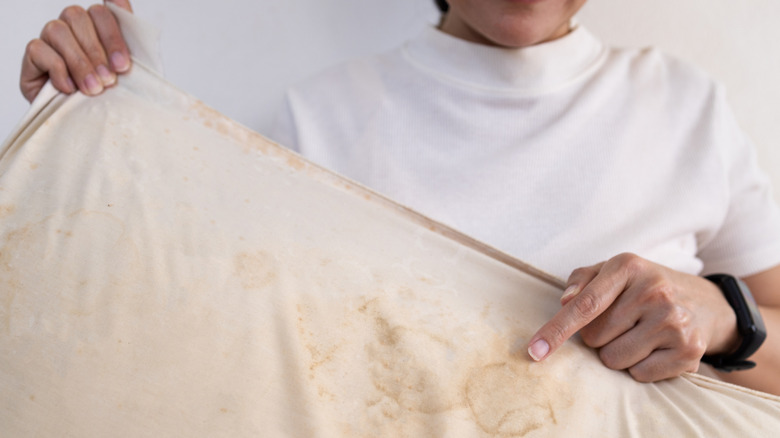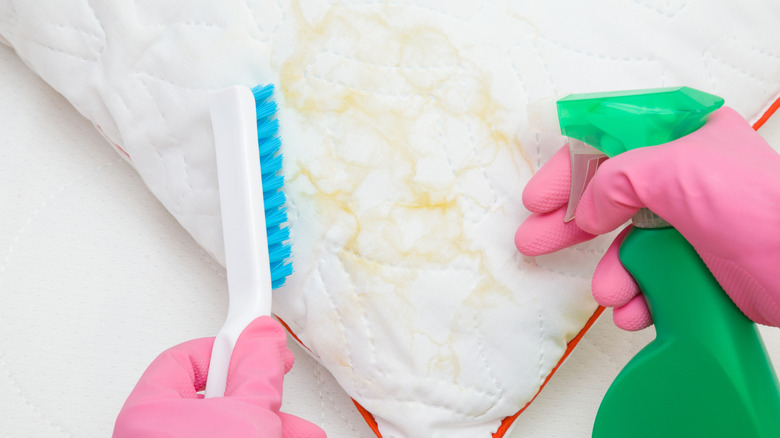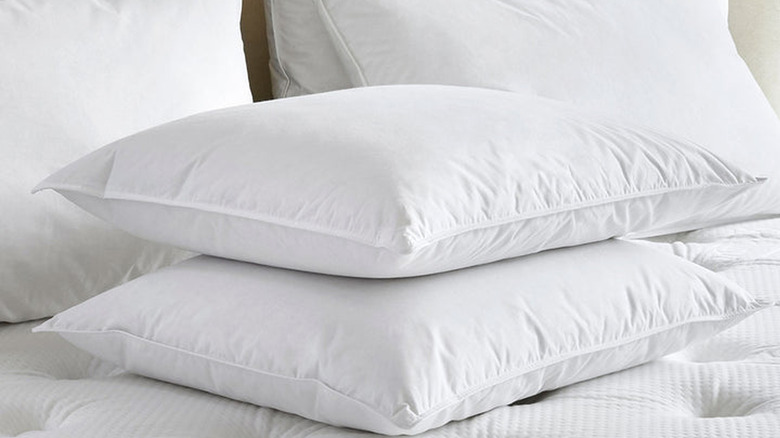Avoid (& Completely Remove) Yellow Pillow Stains With A Few Common Ingredients
There's almost nothing better than slipping into a bed with fresh sheets. But that feeling is lost when you find yellow stains on your pillow. Yellow pillow stains are usually created by a mix of sweat, drool, natural oils from your skin and hair, or skincare products. Although common, they aren't any less disgusting. Your first instinct is likely to toss your pillow to the curb. Before you do, there are some simple ways to get rid of stains without throwing out a perfectly good, although aesthetically unpleasant, pillow. Whether it needs deep cleaning or you want to keep yellow stains away from your pillow, you've got options.
Yellow stains on pillows aren't just an eyesore — they can be a hotspot for bacteria and allergens. While it might seem like a cosmetic issue, it's really about keeping your sleep space clean and healthy. Sure, pillows don't last forever and will need replacing eventually, but you don't have to live with those stubborn yellow patches. With a few common ingredients, like baking soda, hydrogen peroxide, and liquid detergent, you can lift those stains and bring your pillows back to life without spending money.
Knowing how often you should wash your sheets and developing a stain-removal routine are key. Adding a pillow protector can keep pillows from yellowing in the first place. With just a few smart habits and a couple of cleaning tricks, you can avoid and erase those unsightly stains for good.
How to remove yellow pillow stains
Before getting started, check the pillow's care label. Memory foam and feather pillows typically can't go in the washing machine. In that case, there are plenty of washer-free tricks to clean and freshen pillows, but if your pillow is washing machine-friendly, use it to do the heavy lifting for you. Some people have had luck spraying their pillow with water and leaving it outside in the sun. There are others who have soaked their pillows in bleach in the bathtub for a couple of hours with some success. While these might be great for some, they didn't work on our yellow-stained pillows.
The best cleaning tip that gives our bed a luxury hotel feel only takes three products. First, fill up your bathtub with the hottest water possible. Mix 1/4 cup of baking soda and Borax, plus 2 cups of liquid detergent. Stir the water with a spoon and then drop your pillows in. Make sure they're covered by the water, and let them soak for 24 hours. The color of the water will be brown within that time. Next, squeeze the excess water from the pillows and put them in the washing machine. Once the load is finished, toss them in the dryer with dryer balls or tennis balls to add a bit of fluff. If they can't go in the washing machine, rinse them in cold water to remove leftover cleaning products.
Preventing yellow stains on your pillows
Now that your pillows are clean and returned to their original condition, it's important to keep them that way. Although you can't prevent oils from transferring onto your pillow, there are some things you can do to limit it. The first is to make a habit of cleaning your pillows frequently. Since you've removed the old yellow stains, the upkeep isn't as intense. You can throw them in the washer (as long as they're machine washable) and skip the 24-hour soak in the tub. Second, invest in a pillow protector. Think of it as a barrier between your pillow and everything your skin leaves behind at night. A good-quality pillow protector (especially a waterproof one) helps block moisture and oils from soaking into the pillow itself. Just slip it on under your regular pillowcase, then take it off and throw it in with your wash. Picking the best protector will help keep pillows clean for longer.
Other ways to keep yellow stains at bay are as simple as washing your pillow case as often as you do laundry and avoiding going to bed with wet hair, or using a sleep wrap when you do. Keeping your room cool at night or throwing off that duvet cover helps you avoid getting too hot and sweating onto your pillow. And, if you have a nighttime skincare routine, give your products time to absorb before laying your head down for the night.


